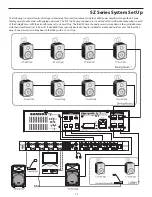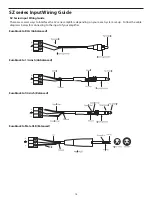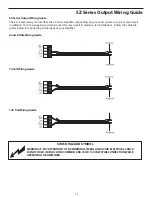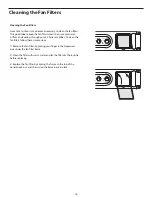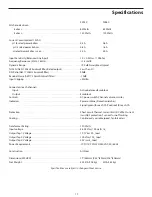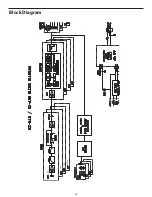
8
Using Active Speakers
In a larger installation, you may use a combination of
passive speakers connected to your SZ series amplifier
along with some active, or self powered speakers in a
different zone. When using active speakers, you can
connect the S zone’s outputs using the balanced line
level signals. In this case you will run line level signal
from the S zone’s Zone Output over the long wire
run to the input of the powered speaker located in
the sound zone. For more information on wiring for
balanced signals, see the wire guide on page 14 of this
manual.
Using Passive Speakers
If you are using passive (un-powered) speakers, you
need to first decide where you will place your power
amplifier. If the speakers in a particular sound zone are
less than 100 feet away you can locate your SZ240 or
SZ480 power amplifier in the same rack as the S zone
and wire the speaker wires from the amplifier to your
sound zone.
NOTE: This type of wiring is known as "home-run
wiring" since you are making direct connection from the
amplifiers in the equipment rack to the speakers located
in the sound zone room.
In this case, you would connect the S zone’s Zone
Output to the SZ series Input and then run the speaker
wires to the passive speakers. Be sure to check the
impedance of speakers you are using. Each channel of
the SZ series amplifiers can run at 4 ohms, so connect
one 4 ohm or two 8 ohm speakers on each SZ output
channel. If the speakers in a particular sound zone are
further than 100 feet, you should consider placing the
amplifier in the same room as the sound zone or use a
constant voltage speaker system.
Using A Constant Voltage Speaker System
If your installation requires multiple speakers and
long cable runs you should consider running a 70 volt,
constant voltage system. Constant voltage systems
became the installation standard in the mid-1900’s
offering a cost effective solution for installations using
multiple speakers and long cable runs. The idea was
borrowed from the cross-country power grid where
voltage is stepped up and therefore the current is
reduced allowing huge amounts of power to run over
long distances on relatively small, lower cost cable.
Ultimately the voltage is stepped down and delivered
to the customer over a short, heavy gauge cable.
Designing an Installation Plan
Now, take some time to consider where you need to
have sound in your particular installation. After you
have decided where you need to create sound zones,
you can consider your speaker selection, but first
decide where you are going to locate your equipment
rack.
Locating Your Equipment Rack
Since the SZ amplifiers and S zone are standard 19-
inch rack mount devices, you should consider using an
equipment rack, such as one of the Samson SRK series.
To select a good location for your equipment rack, you
should consider several points including the proximity
to each of the sound zones, if the users need to access
the gear to change CD’s or to adjust a volume level
and if you have a convenient location to the electrical
service, to name a few. You will need to consider the
length of wire runs and routing necessary to make the
connections from the equipment rack to the various
sound zones. Depending on the speakers you choose,
and the length of cable runs you need to make, you
may choose to run speaker level or line level to the
sound zones. If you are using passive (non-powered)
speakers you will need to connect the output channels
of the S zone to an input channel of the SZ amplifier
and run speaker wire, however you need to be careful
to pay attention to the wire gauge and total length of
the wire run. If you are using powered (active) speakers
you can run long distances using the balanced outputs
directly from the S zone. Since the SZ series' and S
zone's inputs and output connections are terminated
using Euroblock connectors, the wiring can easily be
run in advance of the equipment installation.
Another type of installation is one that uses speakers
and amplifiers (like the SZ series) with 70-volt
transformers, which are commonly referred to as
Constant voltage systems. The benefit of a constant
voltage system is you can run long lengths of wire and
have many speakers connected to a single amplifier.
You can also balance the level of each speaker by using
one of the available transformer settings. The SZ240
and SZ480 amplifiers are ideal for this thanks to their
built-in 70/100 volt output transformers.
Selecting Speakers for Each Zone
To select the speakers, you need to consider a few
important issues like where you are going to place
your power amplifiers, using powered or un-powered
speakers, or if you need to run a 70-volt distributed
sound system. The following sections provide a brief
overview on how to connect active and passive
speakers or a constant voltage system in a typical
installation.

















